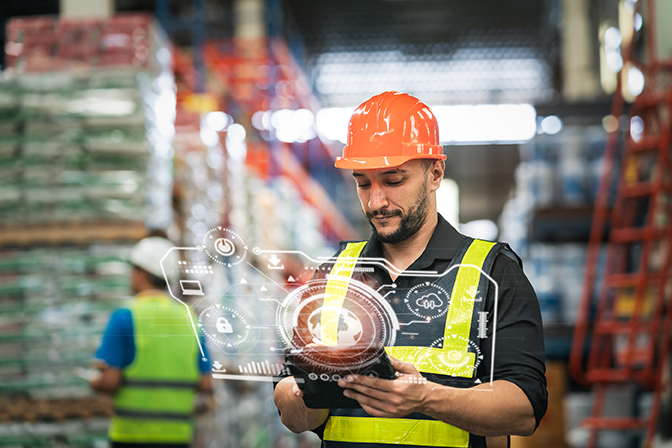Inside the Construction Supply Chain: Trends and Innovations
- Supply Chain
- Construction & Engineering

The construction supply chain is complex. For example, there are several key players and collaborators who work in conjunction with each other both in front and behind the curtain.
Since 2021, the cost of building materials has been increasing in countries all over the world. The producer price of construction materials in the United States reached a growth rate of nearly 27 percent in 2021.
With rising material costs, controlling costs and ensuring efficiency have never been more critical for manufacturers and distributors.
To adapt, construction and building materials companies are getting strategic and implementing new technologies to ensure a strong supply chain.
Let’s take a look at some of the innovations taking place.
Understanding Construction Supply Chain Management
According to a recent report, the global construction materials market size is projected to grow from $1,320.01 billion in 2023 to $ 1,867.16 billion by 2032, at a CAGR of 3.9%. And the industry is only expected to grow.
Central to the construction supply chain is inventory management. Above all, manufacturers of building materials must effectively manage raw materials and finished goods while upholding high-quality standards to ensure availability for building projects.
Additionally, distributors must deliver adequate quantities of materials on time so builders can stay on schedule.
Therefore, more stakeholders and collaborators in the supply chain, the more necessary an efficient inventory management system becomes. A poorly managed inventory can lead to increased overhead costs and low availability of materials, impacting partners downstream. By adopting a lean supply chain framework, construction companies can improve inventory accuracy, reduce excess stock, and enhance supply chain visibility.

The Best Mobile Inventory Software for Construction & Building Materials
GET THE GUIDE »Key Players in the Construction Supply Chain
The construction and building materials supply chain is supported by a diverse group of participants, each playing a critical role in ensuring project success. These key participants include:
- Suppliers
- Manufacturers
- Logistics Companies
- Prime Contractors
- Subcontractors
- Architects and Engineers
Common Challenges in Construction Supply Chains
The larger the supply chain, the more opportunity there is for issues. And for the construction supply chain, these challenges can impact project timelines, costs, and overall business growth.
Common challenges may include:

Your Guide to Solving Supply Chain Management Problems
READ NOW »Fragmentation and Complexity
Because of the complex ecosystem, manufacturers often encounter issues with
- maintaining high production output without sacrificing quality, and
- miscommunications resulting in project delays and increased costs.
To combat this, some are leveraging cloud-based ERP systems to centralize data, so all stakeholders and collaborators are on the same page.
To go a step further, many manufacturers and distributors are using mobile data collection to simplify operations, reduce costs, and enhance their ERP capabilities. This enables businesses to increase output while maintaining the highest possible quality.
Meanwhile, they can be confident that their inventory records are accurate and up-to-date, reducing the chance of miscommunications or missed delivery deadlines.
Raw Materials Shortage
Across industries, there is a shortage of raw materials. Experts relate these issues to global market conditions, natural disasters, and geopolitical events.
As demand increases, the cost rises as well. To combat this, many contractors are diversifying their suppliers and collaborators for more supply chain resilience.
External Factors
Weather, regulatory changes, and unexpected events can throw a wrench in the construction supply chain, creating a need for resilience.
For instance, bad weather can hold up material deliveries, and new regulations might mean you have to change material specs or sourcing methods, leading to more delays and higher costs.
Incorrect Takeoff and Ordering
Contractors can’t make important purchasing decisions without accuracy. They also can’t pass on accurate estimates to clients. Inaccurate construction takeoffs can lead to ordering the wrong quantities of materials, causing significant issues.
Accurate takeoffs are crucial for reliable cost estimates and purchasing decisions. Without it, contractors face:
- penalties for missed deadlines,
- logistical headaches, and
- rebooking issues,
which can jeopardize project timelines and profitability.
Moreover, accurate takeoffs reduce financial risks and enhance contractor reputation and client satisfaction.
To tackle these issues, some contractors are using construction takeoff software construction for better accuracy, cost savings, and faster takeoff creation.
These digital takeoffs eliminate manual calculations.
Additionally, digitalizing inventory management can help contractors better manage materials in real time throughout manufacturing, distribution, and maintenance.

Gain real-time visibility for materials management to improve profitability
LEARN MORE »
Yard Management
All materials for projects aren’t in one space. Many construction companies have storage yards where bulk materials like timber, steel, concrete blocks, and pipes are stored, or remote storage facilities usually for long-term use.
These exterior and outdoor sites typically expand to many acres, making them difficult to track, especially if they are outside Wi-Fi range. So then, gaining visibility seems impossible.
Trends in Construction Supply Chain Management
Labor Shortages
The war for talent is impacting industries across the board. But, for the construction and building materials industry, these labor shortages can lead to delayed projects, inefficient productivity, and poor efficiency.
According to a report from the U.S. Bureau of Labor, construction is predicted to be one of the fastest-growing job sectors until at least 2026.
Proactive construction companies are investing in technology to attract and keep workers engaged.
Moreover, mobile technology is a powerful talent acquisition and retention strategy as it attracts younger workers and can reduce training time by up to 80%. Amidst your talent search, consider investing in a mobile solution that allows your company to do more with fewer people.

Get 100% paperless inventory
DOWNLOAD NOW »Reliance on Subcontractors
Because of labor shortages, many construction companies depend on subcontractors.
Working with subcontractors is a multi-linked process involving coordinating with multiple subcontractors to ensure timely material deliveries, quality control, and efficient communication.
Additionally, most construction supply chains are as strong as their team of collaborators.
Thus, building trust with subcontractors can help your supply chain overcome risks and enhance project outcomes.
Lastly, subcontractors take responsibility for their portion of the work, which includes any defects or issues, thereby protecting the main contractor from liabilities related to specialized areas of the project.
Material Delays and Rising Costs
Material delays and rising costs have been persistent challenges in the construction industry.
According to research from Gordian, construction materials have seen significant price increases since 2020. This accounts for around 82.5% of materials affected. For manufacturers, material delays can disrupt production schedules, causing delays in project completion, and thereby hurting customer satisfaction.
For this reason, it’s vital to increase your supply chain visibility, traceability, and trackability to stay ahead of these challenges.
Best Practices for Effective Construction Supply Chain Management
Planning Orders Based on Forecasts and Historical Data
Accurate data is key for accurate planning in any supply chain. By leveraging historical data from past projects, construction companies can improve decision-making and forecasting.
Implementing robust data collection systems, such as mobile inventory software for construction and building materials ensures that all relevant information is captured and accessible for future planning.
Streamlining Ordering and Billing Processes
Hooking up your ordering and billing processes with accounting systems like Enterprise Resource Planning (ERP) software can simplify your financial management and make sure suppliers get paid on time.
Furthermore, having a centralized system for your data can sync project updates with your accounting data, keeping all invoices and transaction history in one place.
By doing this, you can
- keep an eye on expenses,
- monitor cash flow, and
- stick to your budget,
ensuring your project stays on track and financially sound.
The Role of Technology in Supply Chain Management
From procurement and inventory management to scheduling and budgeting, contractors and project managers are using technology to modernize their supply chain.
More specifically, they are integrating solutions for real-time material visibility, yard management, and stock-level visibility even when workers have no access to Wi-Fi.
The top technologies for improving efficiency and reducing costs include: mobile barcoding, RFID, IoT sensors, and GPS/Geolocation tracking.
Centralized Systems
A notable piece of technology is centralized systems, crucial for streamlining communication among all stakeholders, including contractors, subcontractors, suppliers, and clients.
It’s a single platform like a WMS system or an ERP in which all decision-making and control happen in one entity, thus keeping all team members on the same page.
Many companies are investing in these systems to better collect and share data across departments.
Real-time visibility
When manufacturing construction materials, managers need inventory visibility to track levels accurately, quickly identify bottlenecks before they grow, and comply with EPA, OSHA, and FAR regulations.
High-performing companies implement technologies like mobile inventory to gain real-time visibility. This way, manufacturers can track:
- raw materials,
- work-in-progress projects,
- finished goods,
- high-value assets, and
- spare parts
to ensure project timelines stay on track.
For outdoor spaces like yard storage, mobile offline management software like RFgen can enhance visibility with geolocation capabilities. This type of solution can provide a virtual bin map to guide forklift drivers to their precise destination in the yard using GPS coordinates.
Case Study: Construction Materials Manufacturer Enhances Visibility
To demonstrate how technology can improve supply chain activities for construction, let’s look at one diversified manufacturer’s story:
This U.S.-based manufacturer and supplier of building products needed greater visibility and more reliable inventory levels.
With manual processes, they weren’t able to find inventory efficiently or move materials through the warehouse quickly enough.
To change this, they implemented a mobile data collection solution that included mobile tablets and barcode scanners. This enabled material handlers to capture information on the fly, without forcing material handlers to return to a computer workstation to enter information.
After implementation, the manufacturer’s warehouse teams gained the ability to transact materials in real-time with reliable visibility. Supply chain operations were improved and operations were made more resilient.

Construction Materials Manufacturer Enhances Visibility
READ THE FULL STORY »Keep Up With Trends in the Construction Supply Chain. Stay Competitive
The construction supply chain has seen significant ups and downs in recent years. Companies that make or distribute building materials need to invest in strategic supply chain initiatives to control costs and build resilience. Technology offers an efficient way to do both. Those that fail to adapt to the times risk falling behind the competition.
It’s time to ask yourself: what is the cost of not modernizing my supply chain operations?
Optimize your supply chain for construction and building materials. Talk to the experts at RFgen Software today.
FAQs
1. What are the most common supply chain challenges construction companies face?
Construction companies often encounter material shortages, labor shortages, and supply chain interruptions that delay construction projects and inflate costs. Effective supply chain management can minimize these disruptions, ensuring project timelines stay intact and materials are available when needed.
2. How can construction businesses improve supply chain management for better efficiency?
By investing in mobile inventory management solutions and leveraging historical data, construction businesses can enhance materials management and reduce waste. This approach streamlines supply chain processes, helping project managers track materials and avoid excess inventory or unexpected costs.
3. What role does technology play in successful supply chain management for the construction sector?
Technology solutions like ERP systems and mobile data collection improve visibility, ensuring better supply chain management and quality control throughout the construction process. These tools allow construction companies to track raw materials, manage cash flow, and facilitate timely delivery of building materials to the job site.
4. How can contractors address supply chain issues like material delays and rising costs?
Diversifying suppliers and adopting demand forecasting tools can mitigate material delays and price fluctuations. Construction partners who implement quality control processes during the planning phase are more likely to secure the materials needed and avoid supply chain disruptions.
5. Why is inventory management critical to controlling costs in the construction supply chain?
Proper inventory management prevents excess inventory and wasted materials while supporting accurate billing processes and cost savings. Construction businesses that track materials in real time are less likely to experience project delays, allowing prime contractors to maintain project schedules and deliver quality projects on time.




